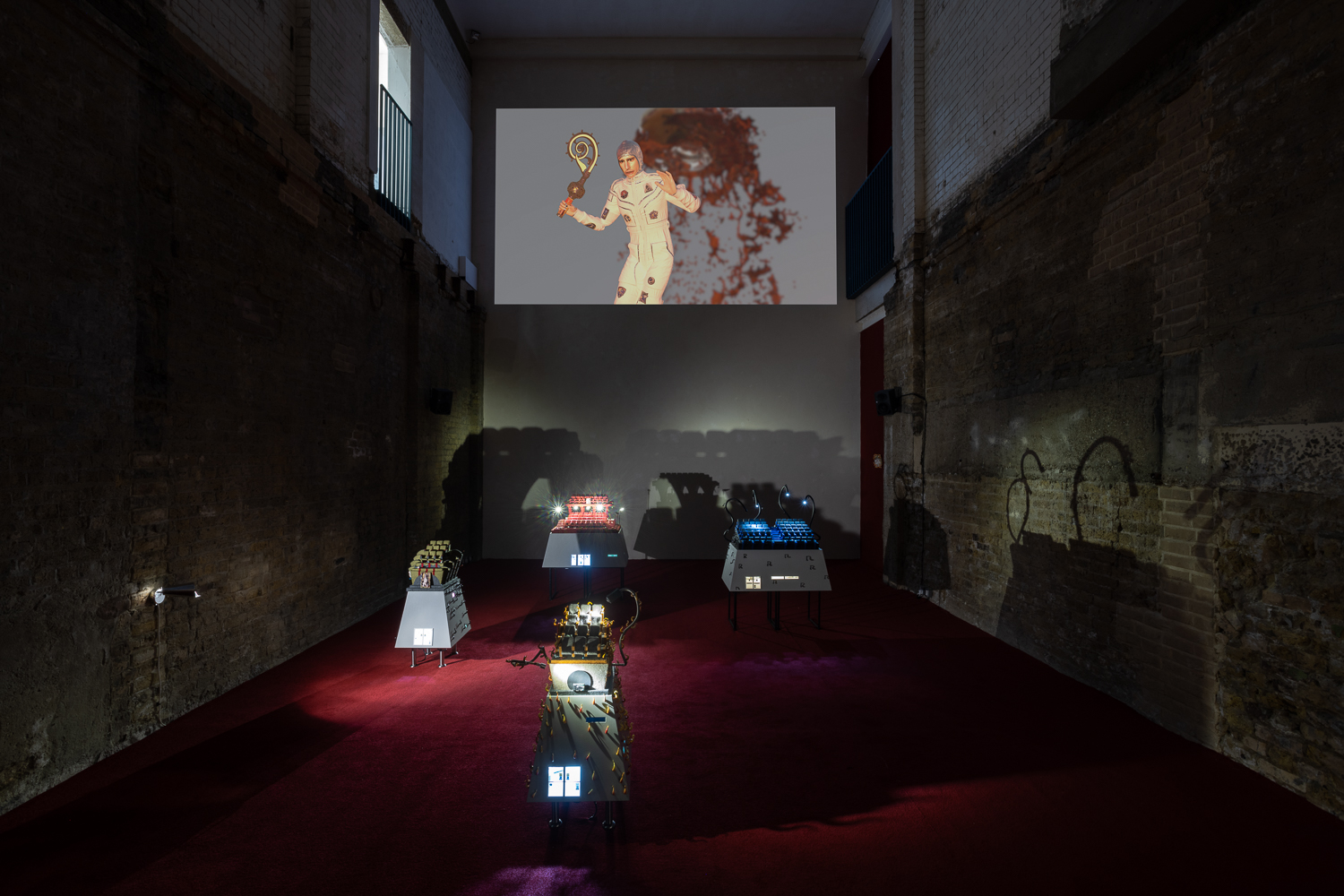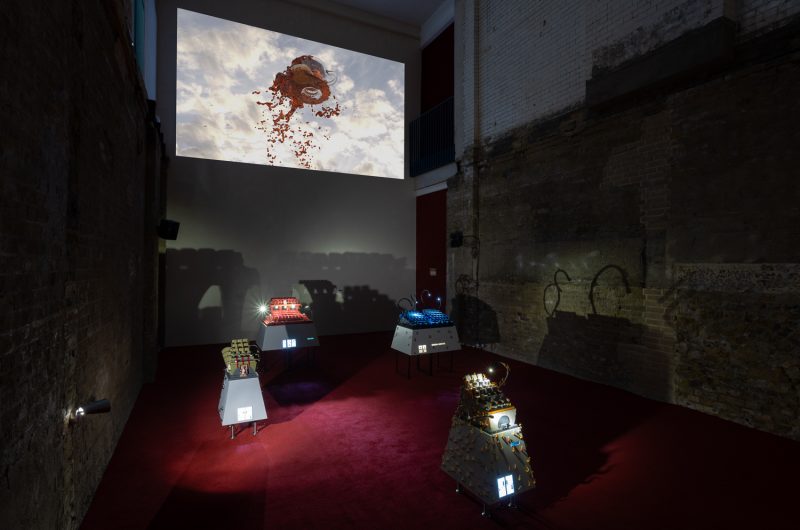TEXT: Jamie Sutcliffe on Kara Chin
Click here for pdf version.
Fearful Jello: On Kara Chin’s Kinematics Of Disaster.
By Jamie Sutcliffe
You may wish it weren’t the case, but you’ve almost certainly been conditioned by them, inducted somehow into their secret language of apprehension… Those gentle ripples on the surface of a glass of water that accompany the muted reverberations of an ancient and colossal footstep. You know the ones I mean, right? Or the panicked murmuration of birds in flight, the agitated barking of neighbourhood dogs, a pair of terrified eyes glimpsed with chilling clarity in the reverse gaze of a rear-view mirror. And most horrifyingly of all for people of a certain age perhaps, that frantically wobbling lump of green jello, balanced upon the tip of a trembling spoon, its holder’s shudders expressive of a newly witnessed threat.
Kara Chin’s Concerned Dogs refines its own anxious lexicon from popular cinema’s visual language of impending disaster. Those economic shorthands that dramatize the encroaching menace of a threat that looms off-screen: still unseen, but palpably, unnervingly, close. Weirdly, Chin’s exhibition choreographs these theatrical markers of potential catastrophe into an uneasy repertoire of kinetic portents that feels so ghoulishly familiar—so intravenously proximate—that its Pavlovian effect instantly betrays it for the early warning system we’ve gradually internalised from years spent bathing in the soft glow of multiplex projectors.
Gathered from a broad filmography that appears to include films such as Steven Spielberg’s Jurassic Park (1993), Alfred Hitchcock’s The Birds (1965), Kornél Mundruczó’s White God (2014) and James Cameron’s Terminator 2 (1991) amongst others, these tropes have been animated by Chin into a short digital slapstick sketch, Inaugurare (2023). The film sees a crudely rendered Tom Cruise (…that bland universal test-subject-cum-sacrifice for all manner of filmic cataclysms…) outfitted in a space suit and fleeing for his life from the mere indexes of an impending disaster, an ancient Roman scrying tool clutched in hand, while an appropriately ominous soundtrack relays the booming approximation of that most ubiquitous sonic marker of dread, the “inception horn”. BRAAAAM! In Inaugurare it appears to be the signal, echo, or imprint of an event that is itself to be feared, not, necessarily, its source or cause.
Figuring catastrophe cinema as some kind of subconscious dress rehearsal for IRL disaster might feel especially resonant in a period of accelerated social and ecological collapse, but it’s hardly the most original take. It’s only when we consider the remarkable contrast of Chin’s film work—projected at a vertiginous height, high above visitors’ heads—to the other components of her exhibition that we realize she’s leading us into far more unusual and irregular territory, departing from a now platitudinous read on the cinematic as an unconscious process of “making visible” our deep-rooted cultural fears, and into her own fraught play on scale and the strangely vulnerable relationality it begs of our bodies.
The plushly carpeted floor of Concerned Dogs is home to a series of miniature dioramas, multiplex micro-dramas each depicting a cinema auditorium populated by carefully upholstered felt seats, their aisles and footwells strewn with an instantly recognizable scattering of late-capitalist flotsam. Here, discarded Pringles tubes compete with verdant eruptions of lichen in an apocalyptic tussle between the critical massing of junk and a post-civilizational re-wilding. Oversized particles of packing foam lay next to tiny crisp packets and disposable vape units—the foam and packets memorialising the eternal trash of the Anthropocene, while the vapes provide grim auguries of ruin as the alleged cause of 2023’s many devastating summer wildfires thanks to their highly combustible components. Biomorphic ceramic forms appear to tease the sides of these models with the malevolent lick of flames, their odd shapes caught somewhere between tongues of fire and the grotesque, exploratory, and tentacular appendages common to the kaiju tradition of “big monster” franchises such as King Kong (1933), Godzilla (1954), The Beast (1996), and later, Cloverfield (2008), Pacific Rim (2013), and my personal favourite, the highly distressing Attack On Titan (2014-23).
Kaiju are a useful touchpoint here, for we ourselves become monstrous antagonists in the presence of Chin’s delicate sculptures, our own viewing habits driven by a maniacal desire to unearth the potential secrets hidden amidst their aisles, stored like outdated bags of popcorn in their hauntingly sparse and curiously functionless basement spaces. Writing on the miniature in her 1984 book On Longing, the poet and literary critic Susan Stewart suggested that the dolls house is utterly “consumed by the eye”, its peculiar distillation of forms and asynchronous ossification of time inducing a voracious appetite in the act of viewing; an eye that hungers for details. When Godzilla first whomped hungrily across Tokyo Bay in 1954, his cumbersome radiation-feeding ferrocement body provided a ready-made allegory for an emergent state of nuclear fretfulness. What kinds of fear do our kaiju-like forms allegorise as we stomp between Chin’s miniatures, our postures alternating between the dominant elevated gaze of the movie monster and the imploring crouch of the supplicant worshipping at the faltering altar of cinema?
Perhaps it’s a fear induced by cinema’s own successive crises? I’m not talking simply about the dramatic decline in ticket sales, industry-wide strikes involving writers, animators, and actors, or the dastardly hegemonising operations of the Marvel Cinematic Universe, but the uncannily vacant architectural condition of contemporary cinema in light of the wholesale flight of viewing into the domestic sanctuary of laptops, softs, and sofas. The diminishment of the cinema’s potency as a space of reverence and reception.
Paul Virilio’s now almost quaint prophesy that any significant technological development is the simultaneous evolution of an unprecedented form of catastrophe translates effortlessly to the truly haunting space of the contemporary cinema auditorium; its capacity for novel disaster has been crystallized perfectly by the “bigger, bolder, better” sequential logic embodied by the successive traumas of the Glen Cinema crowd crush of 1929, the Uphaar cinema fire of 1997, and the notorious “Joker” mass shooting perpetrated by neckbearded incel plonker James Holmes in Aurora, Colorado, in 2012. In a post-pandemic moment especially, the cinema itself takes on the dangerous charge of a site of potential viral transmission, its atmosphere of public spectacle neutralized by the lingering suspicion of contamination and the shared vulnerability of immunological precarity. The novelist Christopher Brookmyre once warned us to beware half-finished places, “…you know, the Death Star, Jurassic Park, Nakatomi Plaza…”. Is there any more resonantly “half-finished” space than a cinema lacking an audience?
If Chin’s wonderfully strange and uneasy works implore us to read cinema as a unique index of contemporary anxieties, it’s not as a tool of petrified prediction or fearful anticipation, but more likely as the recession of a cultural form that we used to invest with such oracular influence. When the stark conditions of an increasingly unstable reality have come to fulfil the dark promises of cinema’s catastrophic imaginary, cinema itself becomes less a tool of speculation and something akin to a record, a black box nestled in the infernal engine room of a world system that is imploding in slow motion.
Read more…BIOGRAPHY
Jamie Sutcliffe is a writer, curator, and codirector of Strange Attractor Press. His writings have appeared in Art Monthly, Frieze, Rhizome, and other publications.
Read Less...

